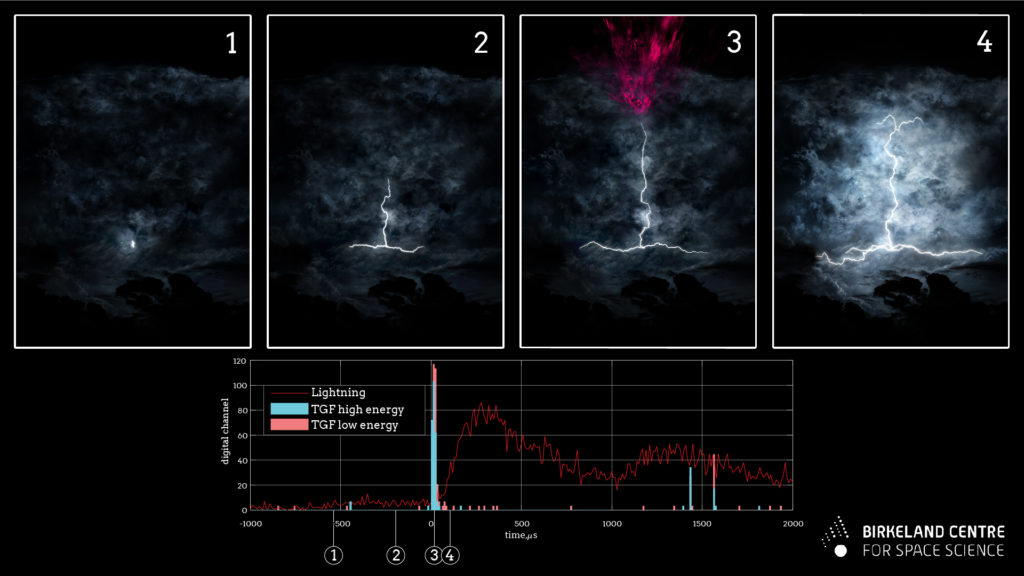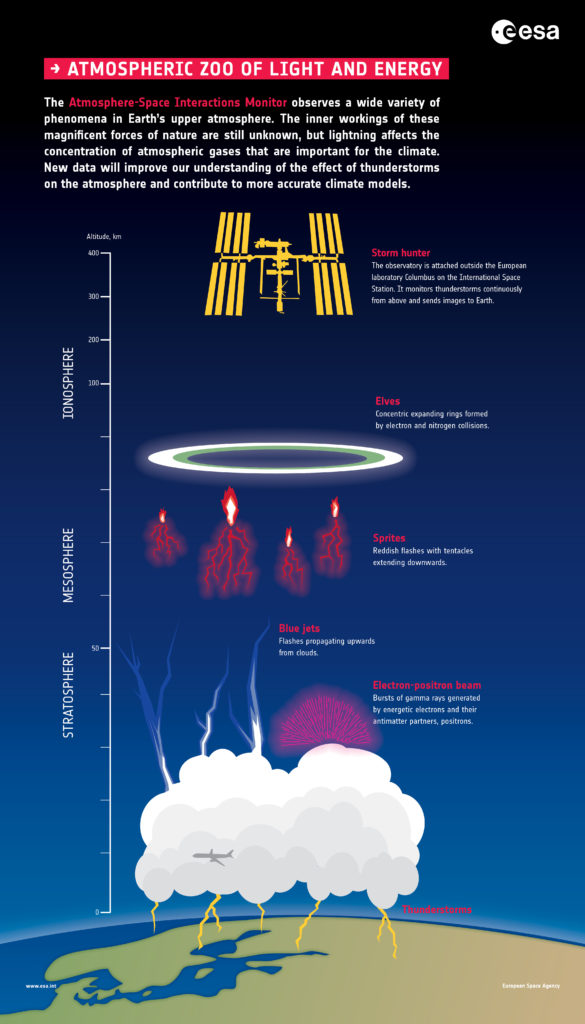10 December 2019

Timing of a terrestrial gamma ray flash from lightning: 1. Lightning leader is initiated, 2. Leader propagates 3. Terrestrial gamma ray flash is produced 4. The leader channel brightens up.
Credit: Birkeland Centere for Space Science / Mount Visual
AGU press contact:
Liza Lester, +1 (202) 777-7494, [email protected]
Researcher contact:
Nikolai Østgaard, Birkeland Centre for Space Science and University of Bergen, +47 4727 0653, [email protected]
SAN FRANCISCO—A slew of new discoveries about the mysterious gamma ray flashes that come from Earth’s thunderclouds are being unveiled in presentations at AGU’s 2019 Fall Meeting and in three new studies being published today.
Scientists accidentally discovered terrestrial gamma ray flashes (TGFs) in 1994 with an instrument on NASA’s Compton Gamma Ray Observatory, which was designed to look for gamma ray flashes in deep space. Subsequent research found that TGFs happen within milliseconds of lightning flashes, but their cause remained a mystery.
Now, scientists working with the European Space Agency’s year-and-half-old Atmosphere-Space Interactions Monitor (ASIM) experiment on the International Space Station (ISS) report they have pinpointed where the powerful gamma ray flashes originate. The researchers also report the first detection by ASIM of an electron beam created by a TGF, the timing of TGFs in relation to lightning, and the first detection a TGF and an elve—a fast, expanding ring of light produced during a thunderstorm at an altitude of 90 to 100 kilometers (55 to 60 miles).
The new findings are being presented this week at AGU’s 2019 Fall Meeting, and in papers published today in AGU’s Journal of Geophysical Research: Atmospheres and Journal of Geophysical Research: Space Physics, and the journal Science.
The research sheds light on these electrical events that occur above thunderstorms and have been difficult for scientists to study until now. The location of the ASIM on the ISS in low-Earth orbit gives scientists a never-before-seen view of these events, and ASIM is the first experiment to use instruments designed to image and analyze both gamma ray flashes and visible lightning at the same time.
The new insights into these poorly understood phenomena could help scientists understand the effects these electrical discharges have on our atmosphere, with implications for how thunderstorms affect our climate.
TGFs are the most energetic naturally-produced phenomena on Earth, with photon energies reaching several tens of millions electron volts. Learning more about them—how they are created and how common they are—is important for fine-tuning models of Earth’s energy balance, which is essential for making accurate climate projections, explained Torsten Neubert of the Technical University of Denmark who is the principal investigator of ASIM.
“By going up above the clouds with ASIM, is like a new window into lightning,” Neubert said.
A new look
One major accomplishment of ASIM, detailed in a new paper in AGU’s Journal of Geophysical Research: Atmospheres, is that it has resolved a long-standing question about the sequence of TGFs and visible lightning: Do they both happen at the same time or does one follow the other?
“We have solved that,” said Nikolai Østgaard a professor at the University of Bergen, Norway and lead author of the new paper. “The optical (visible light) pulse comes after the TGF.”
This sequence, along with identifying that the TGFs are created immediately in front of and before a pulse of electricity shoots through the leader of charged air that becomes a lightning bolt, has important implications for researchers, he said.
This new understanding means scientists can now focus their investigations on that specific part of lightning formation to try and find out how electrons are able to reach the incredible speeds that are required to affect gas molecules so strongly that they must emit gamma rays to calm down.
Caught in the beam
Another ASIM result being reported in AGU’s Journal of Geophysical Research: Space Physics is the first detection by ASIM of a terrestrial electron beam caused by a TGF.
An electron beam is a stream of energetic electrons flowing along Earth’s magnetic field lines. In the case of the electron beam detected on September 16, 2018 and detailed in the new study, ASIM picked up the two-millisecond signal of electrons created by a TGF in a distant thunderstorm. The electrons were shot into space, then caught in Earth’s magnetic field lines and beamed towards the ISS, about 650 kilometers away. This detection confirms previous observations made by The Compton-Gamma-ray Observatory and the Fermi space telescope.
“These beams are very narrow,” explained David Sarria, also of the University of Bergen and lead author of the new study. “You have to be in that beam to detect it. It’s about being in the right place at the right time.”
The data collected about the electron beam was then compared to simulations, which made it possible to better understand the TGF that created it. The new finding brings researchers closer to an understanding of these flashes of radiation that reach 40 million electron volts.
Cue the intra-cloud lightning
Yet another ASIM experiment discovery being reported today is the detection of a TGF in association with an elve. Elves are expanding rings of visible and ultraviolet light that vanish in less than a millisecond above thunderstorms. They are thought to be created by an electromagnetic pulse emitted from the lightning interacting with the ionosphere.
The new data, which is being reported in the journal Science, confirms for the first time that a TGF occurs at the onset of a lightning pulse, which generates an elve in the early stage of a lightning flash.
“Our measurements suggest that the current onset is fast…a prerequisite for elves, and that the TGF is generated in the electric fields associated with the lightning leader,” explained Neubert, who is the lead author of the Science paper.
###
Notes for journalists
The AGU journal papers mentioned in this release will be freely available until January 15, 2019. Journalists and public information officers (PIOs) can download a PDF copy of the article by clicking on the links below.
For information on the Science paper, please refer to the Science Press Package on EurekAlert! at www.eurekalert.org/jrnls/sci/ or contact the SciPak team at +1 (202) 326 6440 or [email protected].
Video and images accompanying this press release can be downloaded from AGU’s newsroom sharepoint site.
Journal of Geophysical Research: Atmospheres paper title
“First ten months of TGF observations by ASIM”
Author contact
Nikolai Østgaard, Birkeland Centre for Space Science and University of Bergen, Bergen, Norway, [email protected], +47 4727 0653
Journal of Geophysical Research: Space Physics paper title
“The first terrestrial electron beam observed by the Atmosphere-Space Interactions Monitor”
Author contact:
David Sarria (not at the AGU meeting), Birkeland Centre for Space Science and University of Bergen, Bergen, Norway, [email protected]
Science paper title
“A terrestrial gamma-ray flash and ionospheric ultraviolet emissions powered by lightning”
Author contact
Torsten Neubert (not at the AGU meeting), Technical University of Denmark, Kongens Lyngby, Denmark, +45 26224265
Related AGU Fall Meeting 2019 presentations and sessions
Author Nikolai Østgaard will present these findings today and tomorrow at the AGU Fall Meeting 2019 at the Moscone Center, 747 Howard St, San Francisco, CA 94103. For information about the AGU Fall Meeting, including the schedule of press events, please visit the Fall Meeting 2019 Media Center. Fall Meeting press conferences will be streamed live on the AGU press events webpage. Reporters can visit this site throughout the meeting to watch press conferences in real time and ask questions via an online chat. Press conference recordings will be archived on AGU’s YouTube channel.
Nikolai Østgaard, AE33A-3133 – One TGF and two elves produced by the same thunderstorm system. , Wednesday, 11 December 2019, 13:40 – 18:00, Moscone South – Poster Hall
Nikolai Østgaard, AE23A-01 – New science results from ASIM, Tuesday, 10 December 2019, 13:40 – 13:55, Moscone South – 215, L2
AE23A – Thunderstorm Effects in the Near-Earth Space Environment I, Tuesday 10 December 2019, 13:40-15:40 Moscone South 215, L2
AE31B – Thunderstorm Effects in the Near-Earth Space Environment II Posters, Wednesday, 11 December 2019, 08:00 – 12:20, Moscone South – Poster Hall
AE33A – Energetic Radiation from Lightning and Thunderstorms I Posters, Wednesday, 11 December 2019, 13:40 – 18:00, Moscone South – Poster Hall
AE41A – Energetic Radiation from Lightning and Thunderstorms II, Thursday, 12 December 2019, 08:00 – 10:00, Moscone South – 215, L2
AE43A – High-Resolution Data Analysis and Modeling in Atmospheric and Space Electricity eLightning, Thursday, 12 December 2019, 13:40 – 15:40, Moscone South – eLightning Theater II
****
Founded in 1919, AGU is a not-for-profit scientific society dedicated to advancing Earth and space science for the benefit of humanity. We support 60,000 members, who reside in 135 countries, as well as our broader community, through high-quality scholarly publications, dynamic meetings, our dedication to science policy and science communications, and our commitment to building a diverse and inclusive workforce, as well as many other innovative programs. AGU is home to the award-winning news publication Eos, the Thriving Earth Exchange, where scientists and community leaders work together to tackle local issues, and a headquarters building that represents Washington, D.C.’s first net zero energy commercial renovation. We are celebrating our Centennial in 2019. #AGU100
*****
